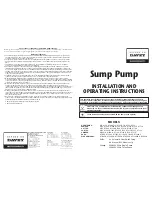
13
SEQUENCE OF OPERATION
Cooling Cycle
Upon cooling demand, the thermostat closes circuit R to O and Y.
Closing R to O and Y energizes the reversing valve for cooling
operation and closes the heat pump contactor, starting the
compressor and outdoor fan. The thermostat automatically
closes R to G circuit, which also brings on the indoor fan at the
same time. Upon satisfying cooling demand, the thermostat will
open the above circuits and open the main contactor, stopping
the compressor and outdoor fan. If the indoor unit is equipped
with a delay timer, the blower will continue to operate for 60 to
90 seconds, which improves system efficiency.
Heating Cycle
Upon heating demand, the thermostat closes circuit R to Y, which
closes the heat pump contactor, starting the compressor and
outdoor fan. The reversing valve is not energized in the heating
mode. The thermostat again automatically brings on the indoor
fan at the same time. Upon satisfying heating demand, the
thermostat opens the above circuits and stops heat pump
operation.
Defrost Cycle
If the outdoor ambient conditions are such that frost forms on the
outdoor coil, the defrost control monitors a defrost cycle. It then
runs the defrost cycle as ambient temperatures require.
The defrost control is time/temperature initiated and temperature
terminated with a maximum defrost time (time-out) of 10 minutes.
The time between defrost cycles is preset at 60-minute intervals
at the factory, but can be field adjusted between 30, 60, or
90 minutes. To adjust the time period between defrost cycles,
see “Adjust Time Between Defrost Cycles” in the “Adjust Defrost
System.”
The defrost control will initiate a defrost cycle when the selected
time period has elapsed and the defrost sensor sees a
temperature below freezing. At the start of a defrost cycle, the
defrost control will energize the reversing valve solenoid, shifting
the reversing valve and de-energizing the outdoor fan. The
defrost relay will also close, energizing temporary heat for
increased comfort during defrost (if the indoor unit is so
equipped). The heat pump will remain in defrost until the defrost
sensor has determined that the frost has been removed from the
coil or a 10-minute period has elapsed, whichever comes first.
Defrost Thermostat
The defrost thermostat is located on the liquid line between the
check/expansion valve and the distributor. When defrost
thermostat senses 42ºF (5.6ºC) or cooler, the thermostat contacts
close and send a signal to the defrost control board to start the
defrost timing. It also terminates defrost when the liquid line
warms up to 70ºF (21.1ºC).
Defrost Control
The defrost control board includes the combined functions of the
time/temperature defrost control, defrost relay, diagnostic LEDs
and terminal strip for field wiring connections. See “Defrost
Control Board” in “Adjust Defrost System.”
The defrost control provides automatic switching from normal
heating operation to defrost mode and back. During compressor
cycle (call for defrost), the defrost control accumulates
compressor run times at 30, 60 or 90 minute field-adjustable
intervals. If the defrost thermostat is closed when the selected
compressor run time interval ends, the defrost relay is energized
and defrost begins.
Defrost Control Timing Pins
Each timing pin selection provides a different accumulated
compressor run time period during one thermostat run cycle. This
time period must occur before a defrost cycle is initiated. The
defrost interval can be adjusted to 30 (T1), 60 (T2) or 90 (T3)
minutes. See “Defrost Control Board” in “Adjust Defrost System.”
The defrost timing jumper is factory-installed to provide a 60-
minute defrost interval. If the timing selector jumper is not in
place, the defrost control defaults to a 90-minute defrost interval.
The maximum defrost period is 14 minutes and cannot be
adjusted.
A test option is provided for troubleshooting. The test mode may
be started anytime the heat pump is in the heating mode and
the defrost thermostat is closed or jumpered. If the jumper is in
the test position at power-up, the defrost control will ignore the
test pins. When the jumper is placed across the test pins for
2 seconds, the defrost control will enter the defrost mode. If
the jumper is removed before an additional 5-second period
has elapsed (7 seconds total), the heat pump will remain in
defrost mode until the defrost thermostat opens or 14 minutes
have passed. If the jumper is not removed until after the
additional 5-second period has elapsed, the defrost will terminate
and the test option will not function again until the jumper is
removed and reapplied.
Compressor Delay
The defrost control board has a field-selectable function to
reduce occasional sounds that may occur while the heat pump is
cycling in and out of the defrost mode. The compressor will be
cycled off for 30 seconds while going in and out of the defrost
mode when the compressor delay jumper is removed.
NOTE: The 30-second “off” cycle is not functional when
jumpering the TEST pins.
Time Delay
The time delay is 5 minutes long. The delay helps to protect the
compressor from short cycling in case the power to the heat
pump is interrupted or a pressure switch opens. The delay is
bypassed by placing the timer select jumper across the TEST
pins for 0.5 seconds.






































